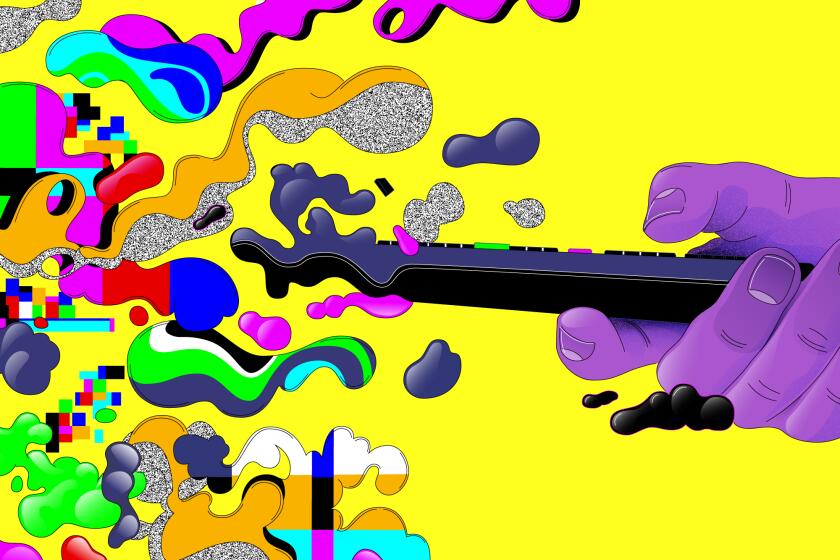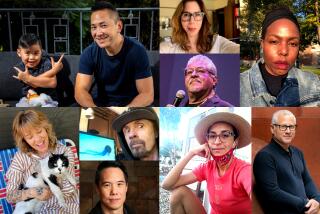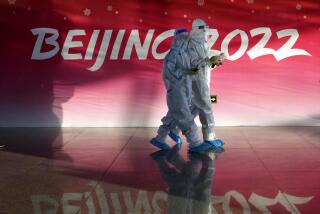- Share via
“American Ninja Warrior” paused filming the day before it was set to begin. The crew dismantled the elaborate course and packed it into 27 semi-trailer trucks, which remained parked in Pomona while countless other productions were postponed due to COVID-19. And Sandy Zimmerman, like the rest of the athletes of the NBC series, scrambled to get herself and her family on a flight home from Los Angeles.
Months later, she was contacted by producers about participating in an abridged and socially distanced season. The course was to be housed at the Dome at America’s Center in St. Louis, “a facility that is so massive there’s enough bathroom sinks that you could pretty much claim your own for the entire shoot,” executive producer Kristen Stabile told The Times.
At this point, Zimmerman, a 44-year-old teacher, had been sheltering in place in Spokane, Wash., for months, juggling home-schooling for her three adolescent kids with virtual physical education activities for her elementary school students. So the thought of leaving it all behind for up to two weeks — previously, the series needed participants for only days at a time — was a big decision, albeit an easy one.
“I have to be completely honest — when I got the call, I thought, ‘Oh my gosh, for two weeks all I have to worry about is myself?’ ” she told The Times with a laugh. “I get to sleep when I want, eat when I want, and unless they need me, I can stay at a hotel and read and binge-watch TV? I am gonna live this up!”
Of course, this wasn’t such a straightforward decision for all 150 competitors — particularly Najee Richardson, a 29-year-old actor who has had asthma since childhood and had rarely left his Philadelphia home since the pandemic hit. “I wasn’t sure I wanted to put myself in a position where I could catch this thing, because I’m not sure if my respiratory system would have the strength to fight it off,” he said.
“But when I heard about all the safety measures [producers] were going to take, it put my mind at ease because I could tell that, for them, it wasn’t just about filming a show,” Richardson said. “They were also worried about taking care of us and making sure we had the best experience possible.”
With profound change comes possibility: As we enter the 2020 fall season, TV has not only the opportunity, but the need, to do so. Here are some ways it might.
So how does one film an athletic competition series amid a worldwide pandemic? With a complete strategic overhaul: no region-specific rounds, no Las Vegas championship, no $1-million prize. Instead, this season, which premieres Monday, culminates in a streamlined $100,000 tournament on the underutilized Power Tower. (Though not every season crowns a winner, this one does.)
The season’s casting also was truncated, with each of the top 50 athletes nominating two additional competitors from their communities. Diverse athletes, as well as healthcare professionals who had been working with COVID-19 patients, were top priorities for inclusion. “We felt it was important for our show to represent and honor the people doing the riskiest and most heroic work across this country,” executive producer Anthony Storm said of the latter group.
Before the competition, athletes filmed their backstories with local camera operators instead of the series’ usual traveling crews. They tested negative for COVID before going alone to St. Louis, where they were put up in individual hotel rooms and retested every few days. To minimize external contact, a catering crew from Minnesota provided all meals for the constantly masked cast and crew — a total number of people less than that of previous seasons, spread out over 400,000 square feet of the Dome and its neighboring convention center on shoot days. And the course itself was wiped down between runs and cleaned with electrostatic disinfection spray systems each evening.
But even with recordings of crowds’ cheers and giant video screens of loved ones urging on contestants in real time, the arena was so quiet that participants could clearly hear hosts Matt Iseman and Akbar Gbajabiamila commenting on their performances — and occasionally shouted back their own retorts. Usually, they’re drowned out by the enthusiasm of an audience filled with friends and family members. In lieu of such support systems, competitors soon found themselves providing each other with the prayers, encouragements and midrun cheers they’d normally receive from their loved ones.
“Had my family been there, I don’t think I would’ve formed such strong bonds with the other Ninjas,” said Zimmerman, competing for her fourth time. Weeks after production wrapped and everyone returned home, “We still talk, we text, we call. I have made some real forever friends — something I did not expect to come out of this very different season.”
Hosted by Leslie Jones, ABC’s “Supermarket Sweep” reboot was filmed during the COVID-19 pandemic — but you might not know it. Here’s how they pulled it off.
Where other series returning to production this summer have decided not to emphasize the familiar features of life in the pandemic, like mask wearing, “American Ninja Warrior” doesn’t shy from the subject — from images of the series’ crew cleaning the obstacle course to a nurse who works with COVID patients competing in scrubs. Nor does it attempt to ignore the nationwide movement against racial discrimination and violence in policing: Numerous participants wear “Ninja for Black Lives” temporary tattoos and T-shirts while performing their athletic feats.
“I mean, this could have a very negative effect on some people who watch the show, because it makes them uncomfortable, because ‘American Ninja Warrior’ is an escape and they don’t want to have to confront the issues that are out in the world,” said Richardson, who competed in the season premiere in a “Ninja for Black Lives” tank top. “They don’t want to have a conversation about Black Lives Matter or having to wear masks.
“But what we’re going through right now in this country is so much bigger than me just playing around on this obstacle course,” he continued. “Something needs to be done about it, and even if it’s as simple as wearing a shirt or talking about it with the hosts, this show confronts all of that head on. That means the world to me. I’ll forever be grateful for that.”
‘American Ninja Warrior’
Where: NBC
When: 8 p.m. Monday
Rating: TV-PG (may be unsuitable for young children)
More to Read
The complete guide to home viewing
Get Screen Gab for everything about the TV shows and streaming movies everyone’s talking about.
You may occasionally receive promotional content from the Los Angeles Times.








